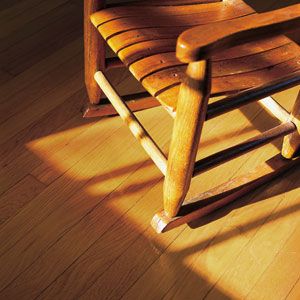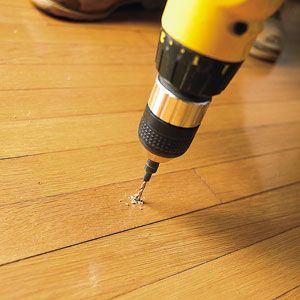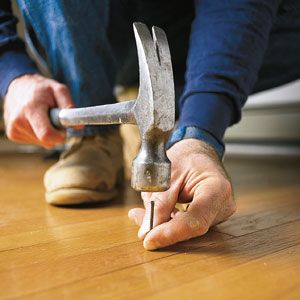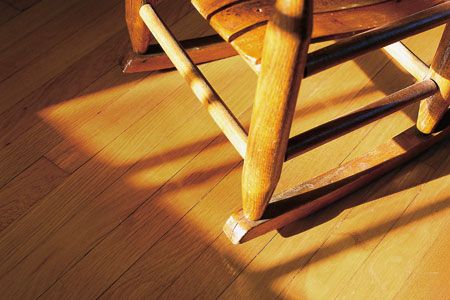
As flooring contractor Patrick Hunt treads across the parlor of the
1860s farmhouse that his parents are restoring, a chorus of loud chirps
and squeaks rises up from the plain-sawn white oak strips beneath his
feet. “Beautiful to look at,” he says. “But what a racket.”
In 17th-century Japan, the shoguns valued (and deliberately built)
squeaky “nightingale floors” as early warning systems against palace
intruders. But Hunt, who with his crew installed the oak and pine in
TOH’s project house in Billerica, is hardly concerned with thwarting
assasins. He just wants to restore a measure of quiet and solidity to
the house. “Eighty percent of the time you’re hearing wood rubbing
against a nail,” Hunt says, shifing his weight and evincing a groan from
one ornery board. “These floorboards swell and contract regularly with
the changing seasons, so the nails, the boards, and even the subflooring
loosen up, causing something to rub against something else.”
Silencing squeaks is generally a simple matter. “In most cases, you can
face-nail the boards back in place,” he says. If that doesn’t work,
lubing them with powder, gluing them back in place, or shimming them
tight may squelch the squawks. But a floor that’s spongy or sagging
could be a sign of serious damage or structural deficiencies, requiring
him to shore up the joists or replace the flooring.
Thankfully, this is not a worry at his parents’ place. After driving
in a few nails, he takes a stroll to test for sounds. Hearing a few
sighs, he smiles. “I’ll leave those,” he says. “Someone else might
call them creaks. But to me, that’s charm.”

The Face-Nail Solution
“Drill a pilot hole first,” says Patrick Hunt, as he fits his drill
with a 3/32-inch bit just a whisker narrower than the 8d finish nail
he’s using. “Otherwise, the wood will split.” Positioning the bit at the
center of the board and at least 3 inches from the end to prevent
splitting, he slowly bores straight down through the wood until he hits
the subfloor, about 3/4 inch below. “Too fast and you’ll create a
sloppy, burred edge,” he says. In the days before power drills,
floor-installers ran finish nails through their hair in lieu of a pilot
hole. “The natural oils made the nails drive through the wood more
smoothly,” Hunt says. “Or you can dull the nail tip with a hammer so the
nail cuts through the wood fibers instead of wedging them apart.”
Hunt positions his 2 1/2-inch finish nail in the pilot hole, then
taps it twice to sink it just shy of flush with the board. “I’m lucky if
I hit a joist, but it’s not necessary,” he says. (In houses that have no
subfloor, Hunt has to make sure the nail goes into the joists, which
always lie beneath the end joints in the flooring.) He’s careful not to
hammer the board lest he leave a crescent-shaped mark or divot on the
wood. Instead he uses a nail set to drive the nail 1/8 inch below the
floor’s surface”).
Using his finger, Hunt fills the indentation above the nailhead with
a tinted oil-based putty, then wipes the surface clean with a cloth. The
filler doesn’t require a finish and comes in a variety of wood hues to
blend with the color of the flooring. “I may mix two or three together
to achieve a perfect match from board to board,” he says. “Plus,
oil-based putty won’t dry out and form a skin that throws off the color
match.”

Baby Powder, Shims, and Adhesive
“Sometimes two boards may rub against each other despite my best
efforts to stabilize them,” Hunt says. As a short-term solution, he
sprinkles the joint with a generous layer of baby powder, which eases
the friction between the boards. Using a wide brush, he works the powder
into the cracks, then sweeps up any excess so the area isn’t slippery.
When the joists or subflooring pull away from the floorboards, every
step causes creaks. If the joists are easily accessible from below, Hunt
watches for movement between the subfloor and the joists as someone else
walks across the floor overhead. Then he gently knocks a shim into the
gap nearest that spot. “I like wood shingles as floor shims because
they’re flat and broad and finely tapered,” he says.
If a gap exists between the flooring and the subfloor, it can’t be
closed up from underneath; filling it with construction adhesive may
stop the noise. First, Hunt drills a 3/16-inch hole in the face of the
flooring strip. Then he fits the nozzle of the adhesive tube into it and
squeezes until he feels resistance. He quickly wipes up the excess with
a cloth soaked with mineral spirits. “The adhesive has to come off
immediately, otherwise it will mar the finish,” he says.
“Putty would pop right out of a hole this size,” Hunt says, so he
fills it with a wood cylinder drilled with a plug-cutting bit out of a
piece of matching scrap. “I always try to use the same species,” he
says. He taps the plug in after the adhesive is dry, then, using a sharp
chisel, slices it off close to the floor surface. Once he sands it down
flush and reseals the wood with a dab of polyurethane, the repair is
virtually invisible.
